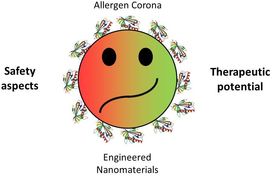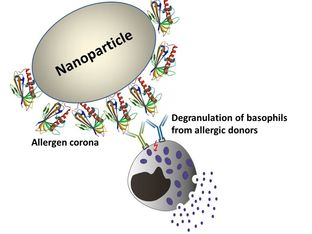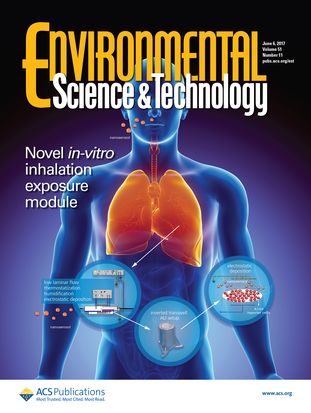Martin Himly
Associate Univ.-Prof. PD. Mag. Dr.
Department of Biosciences & Medical Biology
Division of Allergy & Immunology
Paris Lodron University Salzburg (PLUS)
Hellbrunnerstrasse 34
5020 Salzburg, Austria
Phone: +43-662-8044-5713
Mobile: +43-662-8044-905713
Fax: +43-662-8044-5751
Email:
Web: www.plus.ac.at/himly
Google scholar
ORCID: 0000-0001-5416-085X
Researcher ID: D-1568-2015
LinkedIn: https://www.linkedin.com/in/martin-himly
Welcome to the Respiratory Health & NanoMed Lab!
Our MAIN RESEARCH AREAS are:
-
- nanosafety/-sustainability and -medicine
- innovative advanced materials
- respiratory health & disease
…having TRACK RECORD in:
-
- allergy
- biochemistry
- immunology
- nanosciences
…with a STRONG COMMITMENT for:
-
- Open Science
- data FAIRness (Findable, Accessible, Interoperable, Re-usable)
- quality assurance in Research, Development & Innovation
 Nanomaterials spontaneously bind proteins including allergens. Orientation and selectivity of bound substances represents an intensely investigated field in research on bio-nano interactions. Interactions of allergens with nanomaterials may alter the structure of allergenic epitopes and thus the allergic behavior of bound allergens. This may have positive and negative biological consequences, both are of interest to us.
Nanomaterials spontaneously bind proteins including allergens. Orientation and selectivity of bound substances represents an intensely investigated field in research on bio-nano interactions. Interactions of allergens with nanomaterials may alter the structure of allergenic epitopes and thus the allergic behavior of bound allergens. This may have positive and negative biological consequences, both are of interest to us.
In this regard we are interested in effects nanomaterials may exert in the context of an ongoing type 2 inflammatory disease.
Read more
 The human allergic response can be assessed most realistically by use of primary human basophilic granulocytes or murine cells that were engineered to carry the human receptor for immunoglobuline E, the allergen-specific antibody in patients‘ sera. As such we have a well-defined model system facilitating detailed investigations of nano-bio interactions asking questions like:
The human allergic response can be assessed most realistically by use of primary human basophilic granulocytes or murine cells that were engineered to carry the human receptor for immunoglobuline E, the allergen-specific antibody in patients‘ sera. As such we have a well-defined model system facilitating detailed investigations of nano-bio interactions asking questions like:
– What type of surface characteristics impact the 3D structure of biomolecules due to association with nanomaterial?
– Can structural alterations lead to a new potentially harmful immunological outcome?
– How do bio-nano interactions modify the behavior of foreign matter upon uptake into our body, e.g., via inhalation, ingestion, or injection?
 Inhalation of nanoparticulate substances, e.g., at occupational settings, affects health of the human lung. Current pulmonary research employs a number of advanced cell culture models systems mimicking the situation of the human lung. We have contributed to the field by developing a new nanoaerosol exposure module involving human lung cells growing at the air-liquid interface.
Inhalation of nanoparticulate substances, e.g., at occupational settings, affects health of the human lung. Current pulmonary research employs a number of advanced cell culture models systems mimicking the situation of the human lung. We have contributed to the field by developing a new nanoaerosol exposure module involving human lung cells growing at the air-liquid interface.
Read more






